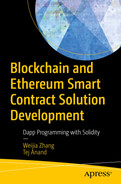Part 2Ethereum Smart Contract Development
In Part 1 of this book, the context of blockchain has been mentioned. In Part 2, you will learn about the Ethereum blockchain and how to write smart contracts with Solidity and then build decentralized applications. Students in our smart contract development courses have built over 30 applications, and we believe that you can learn to do so as well once you follow this book.
In Chapter 6, we go over the Ethereum architecture and decentralized applications. The architectural components at the network layer, core blockchain layer, enterprise component layer, tooling layer, and application layers are explained. Once readers have a good understanding of the Ethereum overview and architecture, the ecosystem and decentralized applications are introduced. To provide readers a better hands-on experience, this chapter also includes setup and development tools, such as geth client, MetaMask, Remix, Truffle, and Web3, to interact with.
Module 1 starts with basic concepts and syntax for Solidity programs. A “HelloWorld” example is presented to explain how to declare a Solidity program, import another Solidity file, and write constructors and functions.
Module 2 describes Solidity data types with emphasis on mapping and structs that are unique to Solidity programming.
Module 3 is focused on events as a messaging mechanism for the Ethereum blockchain and Web3 communications. Readers will learn how to write smart contracts to define and emit events.
Module 4 is about smart contract security and covers various vulnerabilities in functions, data types, access scopes, randomness, signature, etc.
Module 5 describes how to use the security scan, testing tools, and the debugger to improve Solidity code.
Module 6 covers client applications that use Web3 to interact with smart contracts that are deployed to blockchains.
Once readers go through Chapter 7, they should develop a good skill set for writing an end-to-end Solidity program.
Chapter 8 is dedicated to security, with emphasis on various vulnerabilities and best practices to ensure the security of the decentralized applications.
Chapter 9 covers scalability to improve performance and reduce gas fees for the Ethereum blockchain. Layer 2 solutions such as state channel, plasma, rollups, and sharding are introduced and compared.
Chapter 10 describes processes and guides for funding decentralized applications. Token design and distributions are discussed. Transaction gas fee is also explained in this chapter.
Chapter 11 is a real-world example to build a smart contract application from specification to design, followed by the implementation with smart contracts and Web3. This provides an end-to-end experience for readers to develop a smart contract program.
